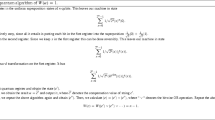Abstract
Walsh spectrum or Walsh transform is an alternative description of Boolean functions. In this paper, we explore quantum algorithms to approximate the absolute value of Walsh transform \(W_f\) at a single point \(z_{0}\) (i.e., \(|W_f(z_{0})|\)) for n-variable Boolean functions with probability at least \(\frac{8}{\pi ^{2}}\) using the number of \(O(\frac{1}{|W_f(z_{0})|\varepsilon })\) queries, promised that the accuracy is \(\varepsilon \), while the best known classical algorithm requires \(O(2^{n})\) queries. The Hamming distance between Boolean functions is used to study the linearity testing and other important problems. We take advantage of Walsh transform to calculate the Hamming distance between two n-variable Boolean functions f and g using O(1) queries in some cases. Then, we exploit another quantum algorithm which converts computing Hamming distance between two Boolean functions to quantum amplitude estimation (i.e., approximate counting). If \(Ham(f,g)=t\ne 0\), we can approximately compute Ham(f, g) with probability at least \(\frac{2}{3}\) by combining our algorithm and \({Approx-Count(f,\varepsilon )\, algorithm}\) using the expected number of \(\varTheta ( \sqrt{\frac{N}{(\lfloor \varepsilon t\rfloor +1)}}+\frac{\sqrt{t(N-t)}}{\lfloor \varepsilon t\rfloor +1})\) queries, promised that the accuracy is \(\varepsilon \). Moreover, our algorithm is optimal, while the exact query complexity for the above problem is \(\varTheta (N)\) and the query complexity with the accuracy \(\varepsilon \) is \(O(\frac{1}{\varepsilon ^{2}}N/(t+1))\) in classical algorithm, where \(N=2^{n}\). Finally, we present three exact quantum query algorithms for two promise problems on Hamming distance using O(1) queries, while any classical deterministic algorithm solving the problem uses \(\varOmega (2^{n})\) queries.
Similar content being viewed by others
References
Beauchamp, K.G.: Applications of Walsh and Related Functions. Academic Press, New York (1984)
Carlet, C.: Boolean Functions for Cryptography and Error Correcting Codes. Cambridge University Press, Cambridge (2007)
Zhang, W.G., Pasalic, E.: Constructions of resilient S-boxes with strictly almost optimal nonlinearity through disjoint linear codes. IEEE Trans. Inf. Theory 60(3), 1638–1651 (2014)
Mesnager, S.: Improving the lower bound on the higher order nonlinearity of Boolean functions with prescribed algebraic immunity. IEEE Trans. Inf. Theory 54(8), 3656–3662 (2008)
Bellare, M., Coppersmith, D., Hastad, J., et al.: Linearity testing in characteristic two. IEEE Trans. Inf. Theory 42(6), 1781–1795 (1996)
Goldreich, O., Goldwasser, S., Ron, D.: Property testing and its connection to learning and approximation. J. ACM 45(4), 653–750 (1998)
Chakrabarty, D., Seshadhri, C.: An o(n) monotonicity tester for Boolean functions over the hypercube. SIAM J. Comput. 45(2), 461–472 (2016)
Grover, L.: Quantum mechanics helps in searching for a needle in a haystack. Phys. Rev. Lett. 79(2), 325 (1997)
Shor, P.W.: Algorithms for quantum computation: discrete logarithms and factoring. In: Proceedings of the 35th Annual Symposium on Foundations of Computer Science, pp. 124–134 (1994)
Aaronson, S., Ambainis, A.: Forrelation: a problem that optimally separates quantum from classical computing. In: Proceedings of the 47th Annual ACM on Symposium on Theory of Computing, ACM, pp. 307–316 (2015)
Ambainis, A., Balodis, K., Belovs, A., et al.: Separations in query complexity based on pointer functions. In: Proceedings of the 48th Annual ACM on Symposium on Theory of Computing, ACM, pp. 800–813 (2016)
Buhrman, H., De Wolf, R.: Complexity measures and decision tree complexity: a survey. Theor. Comput. Sci. 288(1), 21–43 (2002)
Drucker, A., Wolf, R.D.: Uniform approximation by (quantum) polynomials. Quantum Inf. Comput. 11(3), 215–225 (2011)
Li, H.W., Yang, L.: Quantum algorithm for the finding of Boolean functions linear structures. arXiv:1404.0611 [quant-ph], 2 April (2014)
Bernstein, E., Vazirani, U.: Quantum complexity theory. SIAM J. Comput. 26(5), 1411–1473 (1997)
Brassard, G., Hoyer, P., Mosca, M., et al.: Quantum amplitude amplification and estimation. Contemp. Math. 305, 53–74 (2002)
Nayak, A., Wu, F.: The quantum query complexity of approximating the median and related statistics. In: Proceedings of the 31th annual ACM symposium on Theory of computing, ACM, pp. 384–393 (1999)
Li, H.W., Yang, L.: A quantum algorithm for approximating the influences of Boolean functions and its applications. Quantum Inf. Process. 14(6), 1787–1797 (2015)
Chakraborty, K., Maitra, S.: Application of Grovers algorithm to check non-resiliency of a Boolean function. Cryptogr. Commun. 8(3), 401–413 (2016)
De, A., Diakonikolas, I., Feldman, V., et al.: Nearly optimal solutions for the chow parameters problem and low-weight approximation of halfspaces. J. ACM 61(2), 11 (2014)
Braunstein, S.L., Choi, B.S., Ghosh, S., et al.: Exact quantum algorithm to distinguish Boolean functions of different weights. J. Phys. A Math. Theor. 40(29), 8441–8454 (2007)
Acknowledgements
The authors are grateful to the reviewers’ comments and suggestions that greatly help us improve the quality of the manuscript. This work is supported in part by the National Natural Science Foundation of China (Nos. 61572532 and 61272058), the Natural Science Foundation of Guangdong Province of China (No. 2017B030311011) and the Fundamental Research Funds for the Central Universities of China (No. 17lgjc24), and Qiu is partly Funded by FCT project UID/EEA/50008/2013.
Author information
Authors and Affiliations
Corresponding author
Rights and permissions
About this article
Cite this article
Xie, Z., Qiu, D. & Cai, G. Quantum algorithms on Walsh transform and Hamming distance for Boolean functions. Quantum Inf Process 17, 139 (2018). https://doi.org/10.1007/s11128-018-1885-y
Received:
Accepted:
Published:
DOI: https://doi.org/10.1007/s11128-018-1885-y




